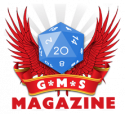If you are creating legends, a few appropriate items won’t go amiss…
Publisher’s blurb: "Enchanted Treasures Worthy of Heroes
Tempered in the fires of creation, these treasures await heroes worthy to bear them. Within this book one will find more than one hundred wondrous and mysterious artefacts, enough to power countless campaigns."
Megan’s review
The Introduction launches straight in to a discussion of the role of magic items in Arcanis. In a word, they’re unusual! Even magic armour and weapons are rare. They are hard to make, involving meticulous preparation, precise crafting and arduous rituals. Few but the dwarves even bother. They should appear only as significant elements in your plots, the object of a quest, perhaps, or reward for some major exploit. So it is worthwhile to make some effort over the ones you include, for they will become notable artefacts, the sort legends build up around and about which songs are sung!
General rules are also dealt with here, mostly concerning how many magical items a character can use at any one time, and explaining the way in which the descriptions of the ones that form the majority of the book are laid out. Trade in magic items is miniscule, you are unlikely to find anyone selling them let alone a whole shop-full, and in the unlikely event a character wants to part with one, a gift to a patron or a protege is more likely than a sale… after all, characters are heroes, not merchants!
Lesser but potent effects can be brought about by carving runes into your weapons or armour, as described in the next section, Runic Items. Again, it is a difficult procedure and few learn and practice the craft. Indeed, an individual runesmith’s work is generally distinctive enough for him to be identified. Although weapons and armour are the most likely places, they also can be placed on shields, wands and even fine clothing. The rune used, of course, determines the effect that can be caused. Runic items are marginally more common than magic ones, but not by much. The item on which the rune is inscribed has to be worn or used normally for the rune to take effect. The section finishes with a list of runes and the effects that they can have – these often vary depending on where you put them: a fire rune, for example, will protect the wearer of armour on which it is inscribed, whereas if you put one on your sword, you can command it to burst into flames, providing light and/or causing fire damage (in addition to normal damage) when you hit someone with it. There’s a wealth of runes available, each with a range of options, so you can devise pretty much whatever you want.
Next follow sections on different items, each providing some examples that you can use or which would serve as exemplars should you prefer to design your own. First, Magical Armour and Shields are discussed. As recommended in the Introduction, each item has a unique title and a backstory… a history that may be used to spawn ideas of how to use it, make it an integral or pivotal part of your plots, or may be something that characters research once they have heard, or even come into possession, of the item in question. In short order, these defensive items are followed by wands, weapons, garb, and miscellaneous gear.
Then comes a section, Elixirs, Oils and Potions. Again crafted through the use of complex rituals, these will cause magical effects when consumed or otherwise used. This is followed by a collection of Alchemical Items. Although their effects may appear magical, are they the creation of a wizard or of science? Most characters will probably just take the benefit of the substance’s effect without worrying too much about how it is made!
Finally, there is a note about the creation and use of Spell Scrolls. These are relatively straightforward to write, provide you know the spell and are willing to put in the time, and even easier to ‘cast’ – anyone can do so simply by breaking the seal on the scroll – or are they? For it is whoever releases the spell that takes the Strain of the casting, and that three-fold! Ouch!
This is a neat supplement packing a lot in, not just information about how magic items, runic items and other magical or quasi-magical things can be made and used, but providing a goodly assortment to get you going or to inspire you in the creation of your own.
Book Details:
Author: Eric Wiener
Publishers’ Reference: PCI1601
ISBN: 978-1931374507
Paperback, 32 pages
Date: November 2011
Buy this product:
- Paradigm Concepts Online Store (Book)
- Amazon.com (Book)
- Amazon UK (Book)
- Paizo (Book)
- DriveThruRPG (PDF download)
- RPG Now (PDF download)
If you have enjoyed this review, please consider donating a small amount of money to help support this website.
Thank you for your support.

![forged-in-magic[1] forged-in-magic[1]](https://www.gmsmagazine.com/wp-content/uploads/forged-in-magic1.jpg) By
By